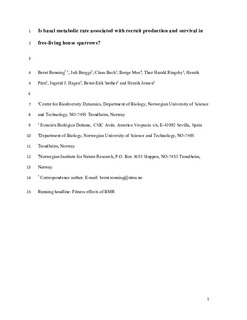Is basal metabolic rate associated with recruit production and survival in free-living house sparrows?
Rønning, Bernt; Broggi, Juli; Bech, Claus; Moe, Børge; Ringsby, Thor Harald; Pärn, Henrik; Hagen, Ingerid Julie; Sæther, Bernt-Erik; Jensen, Henrik
Journal article, Peer reviewed
Accepted version
Permanent lenke
http://hdl.handle.net/11250/2462792Utgivelsesdato
2016Metadata
Vis full innførselSamlinger
- Institutt for biologi [2616]
- Publikasjoner fra CRIStin - NTNU [38672]
Sammendrag
Life history theory predicts that available energy is limited and needs to be allocated among different processes such as growth, reproduction and self-maintenance. Basal metabolic rate (BMR), a common measure of an animal's maintenance cost, is therefore believed to be a trait of ecological and evolutionary significance. However, although BMR is often assumed to be correlated with fitness, its association with individual variation in fitness in free-living populations is virtually unknown.
We examined the relationship between BMR in late winter prior to the breeding season and recruit production (number of offspring recorded the subsequent year), as well as adult survival, in two populations of house sparrow (Passer domesticus) on the islands Leka and Vega in northern Norway.
Number of recruits tended to be negatively related to BMR. However, analysing the data for each sex within the two populations revealed that the negative effect of BMR on recruit production was significant only for females in the Vega population.
Survival probability was associated with BMR, but the relationship differed both between sexes and populations. In the Leka population, we found evidence for stabilizing selection in the females and disruptive selection in the males. In contrast, there was no effect of BMR on survival in the Vega population.
Body mass influenced adult survival, but not recruit production. Furthermore, the relationship between BMR and fitness in females remained significant after controlling for body mass. Thus, the selection on BMR in females was not driven by a BMR-body mass correlation.
Basal metabolic rate was significantly related to fitness in both populations. However, the results in the present study show spatial variation as well as sex specific differences in the influence of BMR on fitness in house sparrows.
